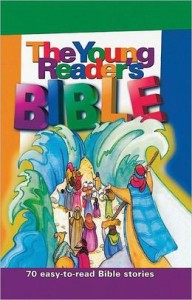 Last Tuesday we looked at a range of new Bible storybooks and early reader “Bibles.” On Friday, we picked our way through the field of Bible translations and compared the most popular for accuracy and readability. Today we’re ready to get down to the meat and bones: just how to you choose a Bible for your child—or possibly for somebody else’s child?
Last Tuesday we looked at a range of new Bible storybooks and early reader “Bibles.” On Friday, we picked our way through the field of Bible translations and compared the most popular for accuracy and readability. Today we’re ready to get down to the meat and bones: just how to you choose a Bible for your child—or possibly for somebody else’s child?
Several months ago a reader asked me if I could recommend a Bible translation for a man in his early twenties who had no church background or familiarity with the word. I was ashamed to say I didn’t really know enough about the newer translations (one reason for Friday’s post). Now I know considerably more, but translation is only half the story. We discussed nine translations, but what about all the editions—study Bibles annotated by popular preachers; devotional Bibles for bikers, cowboys, professional women, teen girls, artists, etc.; show Bibles with designer covers?
And especially children’s Bibles. Online booksellers display pages and pages and pages of these, so how do you sort the best from the rest? We’ll talk about specific examples tomorrow, but today let’s talk about what to consider before you buy.
What do you want from a children’s Bible for your own, one-of-a-kind child? The first thing we all want is help in cultivating a love for the word that will last a lifetime.
- So we’re interested in substance—an accurate translation that’s also readable.
- Memorization is another issue worth thinking about. Most of us have memorized from more than one translation: as a child I started out in the King James; as a college student I memorized from the RSV; as a young wife and mother from the NIV, then the NKJV, and now the ESV. That’s not a big problem, as long as the translation is both accurate and stylistically pleasing. If you decide to start with a children’s translation (NIrV or ICB) you may want to assign memory verses from an adult version.
- Reading level matters if you want the kids to, you know, read those Bibles they’re toting around. If your third-grader is already a voracious reader, you can easily skip the children’s versions and go right to a standard translation like the ESV or NKJV. But not all children learn to read easily or quickly. If you feel they need a little extra encouragement, one of the two children’s translations might be worthwhile. General reading levels for the nine translations I talked about on Friday are as follows: KJV (10th grade), NKJV (8.5), ESV (8), NIV and HCSB (7), NLT (5), Common English Version (4.5), NIrV and ICB (3).
- Supplemental material can easily be too much, but study helps that really help are a plus. I think every children’s Bible should have maps and a basic dictionary. Other helpful additions are charts, lists (kings, parables, miracles, etc.), and family trees.
- Physical details include type size, page weight, and binding. DO NOT buy a softcover edition. Leather or leatherette covers are nice, but expensive for something they’ll soon grow out of; ordinary book board is fine. Look down from the top of the spine and make sure the pages are sewn, not glued—you should see distinct quires, or folded sections. Paper is usually very thin, though some children’s Bibles feature slightly heavier paper than others. The basic problem, of course is that it’s a long book and a Bible constructed of normal book-weight paper would be tiresome to carry. That’s the same problem with type size. In most children’s Bibles the size is 8-9 point, though a few are as large as 10-11. (In one version I saw, the type size was unforgivably small, though there were some other unforgiveable things about that Bible, so I’m not going to mention it.)
- Layout involves whether the text is one column or two, how the numbers arranged (e.g., some editions put verse and chapter numbers in a contrasting colors), and where the “special features” are located. I should say something here about in-text features—those little corners and sidebars scattered throughout the text with memory verses, interesting facts, personal applications, etc. Personally, I find these more distracting than helpful, and would rather see most of this information at the end, or in page inserts. That’s a matter of personal taste, but you need to consider whether in-text features will be gold or clutter.
- Personal taste is a consideration, but probably the one of least importance. I’m talking about your children’s taste, not necessarily yours, although we need to be aware how our own preferences determine our choice. Just because your boy is really into super heroes is not the best reason to pick the Super Hero Bible for him, even though it does have some nice features. And your little girl’s Princess preference (I know I’m speaking in clichés here) doesn’t mean you have to get her a Precious Princess Bible. That also goes for the syndicated character Bibles that are a specialty of Zondervan (because they’re usually NIV or NIrV), like the Berenstain Bears or Veggie Tales. In a few years, your kids will be embarrassed that they ever even watched Veggie Tales. Besides, God calls us to adapt to him; he doesn’t adapt himself to our latest enthusiasm. So in general you should avoid the trendy and focus on the basics.
Study Bible or devotional Bible–what’s the difference? Pretty much what you’d think. The former provides theological interpretations, notes on the Greek or Hebrew text, historical backgrounds and whatever else will help you understand the scriptures. The purpose of a Devotional Bible is to help you apply the scriptures. I have some reservations about devotional guides, discussed here. Whether or not to use them depends on the parent’s evaluation of what each child needs. Th ere are a few examples of actual Study Bibles for kids, and I’ll talk about them. But first, here’s one way to transition from storybooks to the real source:
ere are a few examples of actual Study Bibles for kids, and I’ll talk about them. But first, here’s one way to transition from storybooks to the real source:
The Young Reader’s Bible, by Bonnie Bruno, illustrated by Carol Reinsma. Standard Publications, 2005, 448 pages. For ages 5-10.
This is part storybook, part study Bible. For children who are reluctant or late-developing readers, it’s a nice way to move into actual Bible study. Seventy stories cover the sweep of biblical narrative, but what sets it apart is the supplementary material: Who’s Who in the Bible, Old Testament overview, New Testament overview, How We Got the Bible, and Maps. The book is paperback (Perfect bound) so it might not hold up too well, but for a large family or reluctant readers it could be a good investment.
In light of the considerations above, how do popular children’s Bibles stack up? I’ve been stalking the online sellers and my local Christian bookstores to find out. Check back tomorrow for results!
Support our writers and help keep Redeemed Reader ad-free by joining the Redeemed Reader Fellowship.
Stay Up to Date!
Get the information you need to make wise choices about books for your children and teens.
Our weekly newsletter includes our latest reviews, related links from around the web, a featured book list, book trivia, and more. We never sell your information. You may unsubscribe at any time.
We'd love to hear from you!
Our comments are now limited to our members (both Silver and Golden Key). Members, you just need to log in with your normal log-in credentials!
Not a member yet? You can join the Silver Key ($2.99/month) for a free 2-week trial. Cancel at any time. Find out more about membership here.
3 Comments
Leave a Comment
You must be logged in to post a comment.


Is the 2005 version any different than the 1998 hardback version? I have the devotional guide from this series but not the Bible.
Sarah,
I wasn’t aware there was an earlier version of the Young Readers Bible, but my guess is they haven’t changed much.
[…] https://www.openupthebible.com/articles/choosing-a-childrens-bible https://redeemedreader.com/2013/04/choosing-your-childs-first-real-bible-some-considerations/ […]